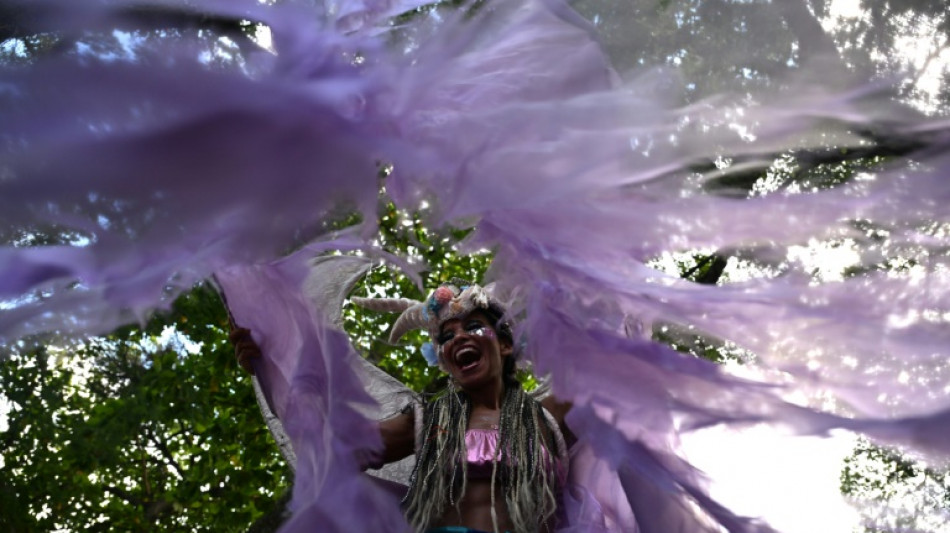
-
 Long delayed Ukrainian survival video game sequel set for release amid war
Long delayed Ukrainian survival video game sequel set for release amid war
-
Star Australian broadcaster charged with sex offences

-
 Philippines cleans up after sixth major storm in weeks
Philippines cleans up after sixth major storm in weeks
-
Woman-owned cafe in Indonesia's Sharia stronghold shakes stigma

-
 Indigenous Australian lawmaker who heckled King Charles censured
Indigenous Australian lawmaker who heckled King Charles censured
-
End of an era as Nadal aims for winning Davis Cup farewell

-
 Trump taps big tech critic Carr to lead US communications agency
Trump taps big tech critic Carr to lead US communications agency
-
Mitchell-less Cavs rip Hornets as perfect NBA start hits 15-0

-
 Markets swing after Wall St losses as traders weigh US rates outlook
Markets swing after Wall St losses as traders weigh US rates outlook
-
India's capital shuts schools because of smog

-
 Rio under high security for G20 summit
Rio under high security for G20 summit
-
G20 leaders to grapple with climate, taxes, Trump comeback

-
 Hopes set on G20 spurring deadlocked UN climate talks
Hopes set on G20 spurring deadlocked UN climate talks
-
Gabon early results show voters back new constitution

-
 Child abuse police arrest star Australian broadcaster
Child abuse police arrest star Australian broadcaster
-
Disgraced Singapore oil tycoon to be sentenced for fraud

-
 Stray dogs in Giza become tourist draw after 'pyramid puppy' sensation
Stray dogs in Giza become tourist draw after 'pyramid puppy' sensation
-
UN Security Council to weigh call for immediate Sudan ceasefire

-
 Is AI's meteoric rise beginning to slow?
Is AI's meteoric rise beginning to slow?
-
Israeli strikes on Beirut kill six, including Hezbollah official

-
 Rain wipes out England's final T20 in West Indies
Rain wipes out England's final T20 in West Indies
-
US speaker opposes calls to release ethics report on Trump's AG pick

-
 McDonald's feast undercuts Trump health pledge
McDonald's feast undercuts Trump health pledge
-
Thousands march through Athens to mark student uprising

-
 NBA fines Hornets' Ball, T-Wolves' Edwards, Bucks coach Rivers
NBA fines Hornets' Ball, T-Wolves' Edwards, Bucks coach Rivers
-
China's Xi says to 'enhance' ties with Brazil as arrives for G20: state media

-
 Bills snap nine-game Chiefs win streak to spoil perfect NFL start
Bills snap nine-game Chiefs win streak to spoil perfect NFL start
-
Biden answers missile pleas from Ukraine as clock ticks down

-
 Senegal ruling party claims 'large victory' in elections
Senegal ruling party claims 'large victory' in elections
-
Dutch plan 'nice adios' for Nadal at Davis Cup retirement party

-
 Trump meets PGA boss and Saudi PIF head amid deal talks: report
Trump meets PGA boss and Saudi PIF head amid deal talks: report
-
UN chief urges G20 'leadership' on stalled climate talks

-
 Steelers edge Ravens, Lions maul Jaguars
Steelers edge Ravens, Lions maul Jaguars
-
No.1 Korda wins LPGA Annika for seventh title of the season

-
 Biden touts climate legacy in landmark Amazon visit
Biden touts climate legacy in landmark Amazon visit
-
England secure Nations League promotion, France beat Italy

-
 Star power fails to perk up France's premiere wine auction
Star power fails to perk up France's premiere wine auction
-
Rabiot brace fires France past Italy and top of Nations League group

-
 Carsley relieved to sign off with Nations League promotion for England
Carsley relieved to sign off with Nations League promotion for England
-
Sinner says room to improve in 2025 after home ATP Finals triumph

-
 Senegal counts votes as new leaders eye parliamentary win
Senegal counts votes as new leaders eye parliamentary win
-
Biden clears Ukraine for long-range missile strikes inside Russia

-
 Lebanon says second Israeli strike on central Beirut kills two
Lebanon says second Israeli strike on central Beirut kills two
-
Puerto Rico's Campos wins first PGA title at Bermuda

-
 Harwood-Bellis risks wedding wrath from Keane after England goal
Harwood-Bellis risks wedding wrath from Keane after England goal
-
'Nobody can reverse' US progress on clean energy: Biden

-
 NBA issues fines to Hornets guard Ball, T-Wolves guard Anthony
NBA issues fines to Hornets guard Ball, T-Wolves guard Anthony
-
Biden allows Ukraine to strike Russia with long-range missiles: US official

-
 Britain dump out holders Canada to reach BJK Cup semi-finals
Britain dump out holders Canada to reach BJK Cup semi-finals
-
Biden clears Ukraine for missile strikes inside Russia


Parades, parties, pageantry: What to know about Rio's Carnival
After weeks of sweaty, pulsating street parties, the Rio Carnival reaches its crescendo this Sunday with its main event, in which samba schools compete in dazzling parades.
Here are five things to know about the Rio Carnival:
- The Sambodrome -
Rio de Janeiro vibrates with Carnival fever throughout February, but the main event is the parade of samba schools through the massive "Sambodrome" venue.
For two nights, the schools -- community organizations deeply rooted in Brazil's vibrant samba culture -- try to out-strut, out-shimmy, and out-shine their competitors in massive parades.
These feature elaborate, massive floats, fantastical costumes, and intricate choreography by performers dancing to the beats of a specially composed samba.
Each parade can include up to 3,000 participants who move up the 700-meter (2,300-foot) long avenue flanked by up to 70,000 spectators.
This year 12 schools will compete for the coveted title of Carnival champion.
Much like football teams, each school has its fervent fans.
There are also different divisions in which schools rise and fall -- and getting to the main competition in the Sambodrome is no easy feat. Rio de Janeiro alone has 120 schools.
Those who make it are called the "Special Group."
They put on a million-dollar production, with up to 75 minutes to seduce the jury with their story told in music and dance.
Themes often revolve around social and political issues or key historical events.
Tickets to the event cost between $14 and $400.
- Street Carnival -
For most revelers, the real Carnival happens far from the iconic Sambodrome, in hedonistic street "blocos."
These parties, whose name refers to the neighborhood blocks they are held on, are thronged by thousands, some of whom dance in place, while others move through the streets following bands performing live music.
Drums, costumes and flowing alcohol -- even when the party starts early in the morning -- are the name of the game.
Blocos mostly have themes and there are some for all tastes. Loucura Surburbana (Suburban Madness) and Zona Mental are for patients and workers from mental health hospitals.
The "Sergeant Pepper" bloco plays Beatle songs, Besame Mucho (Spanish for kiss me a lot) plays samba versions of famous tangos and even the infectious tune "Despacito."
This year there will be some 600 blocos in the city.
- Serious business -
Behind the pleasure-fueled festivities lies some serious money.
This year the Rio Carnival received its largest-ever cash injection from the state government, 62.5 million reais (USD $12.5 million), 40 million of which went to the samba schools.
The Rio prefecture allocated them another 40 million reais.
Carnival will bring in about USD $1 billion to the local economy, according to official statistics.
This is 18 percent more than in 2023.
The whole of Brazil will see its economy boosted by $1.8 billion.
- Water guns and urine -
Carnival is not all fun and games, with crowded events rife with opportunity for pick-pockets.
The northeastern state of Bahia has recently banned water pistols at parties after images went viral of a woman being surrounded and pushed around by a group of men carrying the toys.
And beneath the glamour and glitter, lies a lot of pee.
The city of Rio has announced that once the party is over, it will use 2,000 liters of concentrated eucalyptus essence to rid the streets of the odor of urine.
- Other cities party too -
Rio may be the most emblematic of Brazil's Carnival extravaganza, but many of the country's cities come to a standstill.
Authorities estimate some 15 million people will take to the streets in the economic powerhouse Sao Paulo, which boasts 500 blocos.
In the southeastern city of Belo Horizonte, some five million people will party, while another three million will join in on the fun in northeastern Recife.
It is that city which holds the Guinness Record for the biggest bloco, which brought together 2.5 million people last year.
O.Ortiz--AT



